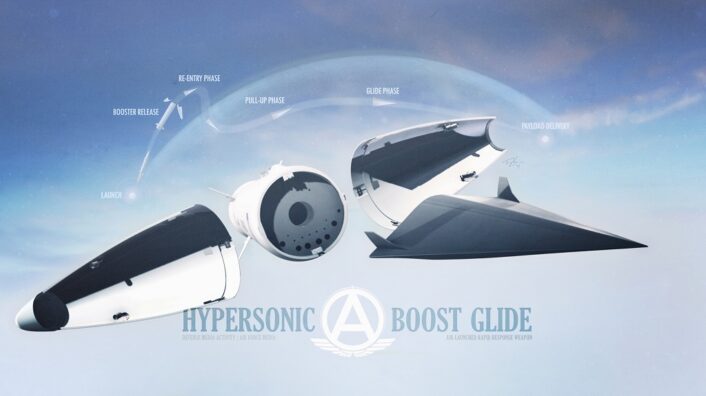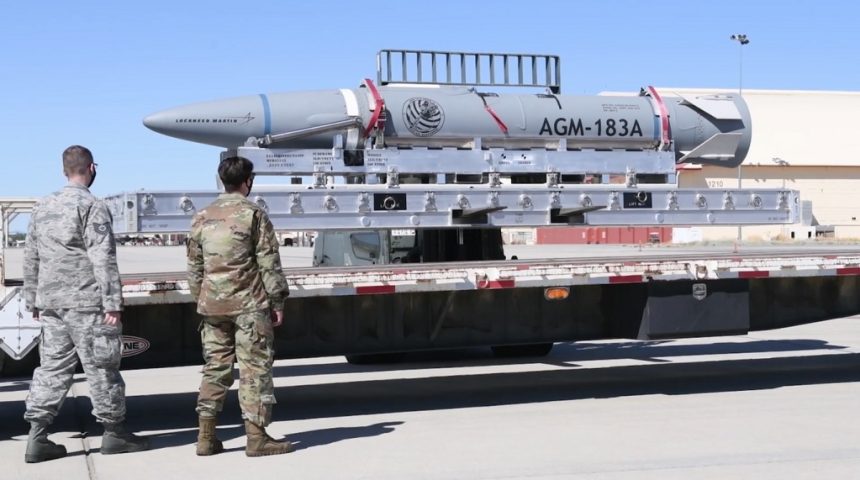The ARRW missile’s rocket motor failed to ignite after it was released by the B-52 over Point Mugu Sea Range.
The U.S. Air Force conducted its second AGM-183A Air-launched Rapid Response Weapon (ARRW) booster flight test on July 28, 2021, but, for the second time, it did not go as planned. The ARRW test missile, designated Booster Test Vehicle 1b (BTV-1b), was released by an Edwards AFB’s B-52H Stratofortress over Point Mugu Sea Range but its rocket motor failed to ignite after the separation.
Several objectives were planned for this test, including demonstrating the safe release of BTV-1b and assessing booster performance. While it did not meet all flight objectives, the Air Force said that the test demonstrated several first-time events as the program continues to track toward fielding a hypersonic capability in the early 2020s.
According to the press release, the ARRW missile cleanly separated from the aircraft and successfully demonstrated the full release sequence including GPS acquisition, umbilical disconnection and power transfer from the aircraft to the missile. The missile also demonstrated fin operation and de-confliction maneuvers which ensures a safe operation for the aircrew.
Dr. Mark J. Lewis, former Air Force Chief Scientist, gave us an in-depth look into how the @usairforce is developing hypersonic technology.
🔗 https://t.co/Bsqs0NglcD pic.twitter.com/iGiuPcghoS
— Airman Magazine (@AirmanMagazine) July 26, 2021
“Developing first-of-its-kind missiles is difficult business and this why we test,” said Brig. Gen. Heath Collins, the Air Force Program Executive Officer for Weapons. “This is a critical capability for our Air Force and we have the very best team working to figure out what happened, fix it and move out to deliver ARRW to our warfighters as quickly as possible.”
The first flight test attempt happened in April, but in that occasion the Air Force stated that the BTV was unable to complete the launch sequence and was not released by the B-52, which then safely returned to Edwards AFB with the ARRW missile still on board. The test flight attempt, which was already late as it was initially planned by the end of 2020, was then delayed another time while the issue that prevented the launch was investigated.
The AGM-183A ARRW is based on hypersonic glide vehicle technology derived from the Air Force and Defense Advanced Research Projects Agency (DARPA) Science and Technology (S&T) Demonstration known as Tactical Boost Glide (TBG). A fragmenting glide vehicle is launched from a conventional rocket, or more precisely a Solid-Rocket Motor (SRM) booster, to the upper atmosphere and, once it reaches hypersonic speeds, it separates from the rocket and glides to its target at speeds up to Mach 15. At these speeds, there is no need for a conventional explosive warhead as the kinetic energy alone delivered during impact would be enough to destroy most targets.

The Air Force also defines the ARRW as an “operational hypersonic air-launched weapon enabling the U.S. to hold fixed, high value, time-sensitive targets at risk in contested environments from standoff distances.” The missile will provide a survivable, lethal, long-range strike capability to go after high-end capabilities of a potential adversary, such as deep-inland strike against targets of strategic importance and coastal strike against high-end systems. These characteristics are a consequence of the extremely high speed and the capability to maneuver the glide vehicle away from threats (InterContinental Ballistic Missiles lack this capability and thus are more predictable) which, in turn, make the weapon almost impossible to intercept.
In an interview to Airman Magazine last month, the former Director of Defense, Research and Engineering Dr. Mark J. Lewis spoke about the advantages of hypersonic technology:
So, what does that combination of speed, maneuverability, and altitude do for me? One, it lets me get to a target quickly. I get inside an opponent’s OODA loop, observe, orient, decide, and act. I’m going so quickly, that I don’t give them enough time even to know what I am much less react. A rule of thumb, if I’m traveling at about five times the speed of sound, I’m going about a mile every second. Think about that.
Count the seconds, that’s how many miles you’ve covered and so a decision-maker, someone who’s looking at one of the systems coming towards them, if they wait 10 seconds to decide, that’s 10 miles I’ve traversed. All right, that’s the first thing.
The second is maneuverability, that means I’m unpredictable. I’ll compare it to an intercontinental ballistic missile, an ICBM. By its very nature, when an ICBM launches, and shortly after it lofts and then the warhead separates, you pretty much know where it’s going to land. Physics governs the trajectory. It’s governed by gravity, and it is the dominant force.
A hypersonic vehicle in the atmosphere can add aerodynamic forces to other forces, to gravity, for example. So that means I can use control surfaces. I can bank right. I can go left. I can pitch. I can dive. I can do all these things, and so it’s much harder to figure out where I’m going. Again, it makes it more difficult for an adversary to anticipate, intercept and act against: the other thing that hypersonics gives me.
A hypersonic vehicle, by its very nature, is going fast. It has energy. That energy can be part of what I deliver. So today you launch a missile, and in the end, you depend on a warhead, something that explodes to create an effect. A hypersonic vehicle traveling fast enough can create an effect all of its own just using its own kinetic energy, so that’s a valuable contribution. When you put all those things together I think you can see why it’s a very, very attractive capability.
Now, why would we want this? The way that we fight wars, the American way of fighting, we rely on technology. We also rely on our skilled warfighters. But it’s that combination of technology and our skilled people that give us that edge. I would argue that’s been true since the founding of this nation. That’s one of the things that the American warfighter brought to the field of battle from the very beginning of this nation. Hypersonics continues that. Hypersonics is a result of how we’ve been operating for the last however many years. What are the next technologies that we need to focus on to modernize and change the way we do things?
The ARRW program seems to be still on track, according to the Air Force, as it is moving forward at a very aggressive pace. Time is critical however, as Russia and China have been openly bragging about their new hypersonic capabilities and claiming that they already have operational hypersonic weapons, so the Air Force is accelerating the time scale, pushing boundaries and taking calculated risks to move this important capability forward.
Hypersonic weapons, like the ARRW, however, are double edged weapons, as described by Dr. Lewis in two examples. “Suppose a target is very heavily defended with a high-end integrated air defense system, or IADS. In that case, hypersonic strike systems allow the U.S. to rapidly take out that IADS from long range with highly survivable, lethal effects. With stealth, they can’t see me, but with hypersonics, they might be able to see me, but they can’t stop me. […] If someone can sink an aircraft carrier or render an airfield unusable with a tactical hypersonic system, then they produce the effect that in some ways is equivalent to using a strategic system. Very simply an adversary (that has hypersonic weapons) no longer needs to have a world-class air force to beat our world-class Air Force. They no longer need to have a world-class navy to beat our world-class Navy.”









